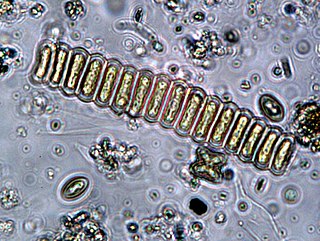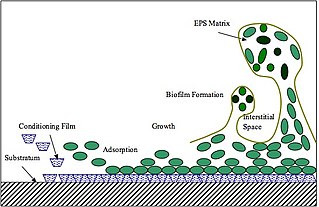
Ramsar is a city in the Central District of Ramsar County, Mazandaran province, Iran, serving as capital of both the county and the district.

Microalgae or microphytes are microscopic algae invisible to the naked eye. They are phytoplankton typically found in freshwater and marine systems, living in both the water column and sediment. They are unicellular species which exist individually, or in chains or groups. Depending on the species, their sizes can range from a few micrometers (μm) to a few hundred micrometers. Unlike higher plants, microalgae do not have roots, stems, or leaves. They are specially adapted to an environment dominated by viscous forces.

A biorefinery is a refinery that converts biomass to energy and other beneficial byproducts. The International Energy Agency Bioenergy Task 42 defined biorefining as "the sustainable processing of biomass into a spectrum of bio-based products and bioenergy ". As refineries, biorefineries can provide multiple chemicals by fractioning an initial raw material (biomass) into multiple intermediates that can be further converted into value-added products. Each refining phase is also referred to as a "cascading phase". The use of biomass as feedstock can provide a benefit by reducing the impacts on the environment, as lower pollutants emissions and reduction in the emissions of hazard products. In addition, biorefineries are intended to achieve the following goals:
- Supply the current fuels and chemical building blocks
- Supply new building blocks for the production of novel materials with disruptive characteristics
- Creation of new jobs, including rural areas
- Valorization of waste
- Achieve the ultimate goal of reducing GHG emissions

Bioenergy is a type of renewable energy that is derived from plants and animal waste. The biomass that is used as input materials consists of recently living organisms, mainly plants. Thus, fossil fuels are not regarded as biomass under this definition. Types of biomass commonly used for bioenergy include wood, food crops such as corn, energy crops and waste from forests, yards, or farms.

Energy crops are low-cost and low-maintenance crops grown solely for renewable bioenergy production. The crops are processed into solid, liquid or gaseous fuels, such as pellets, bioethanol or biogas. The fuels are burned to generate electrical power or heat.

Shahid Bahonar University of Kerman (SBUK) is a research institution and university of engineering and science in Iran, which offers both undergraduate and postgraduate studies. Located in the Kerman province of Iran, the university is among the top ten universities and research institutes in Iran, illustrating its high status in research and education. The SBUK occupies an area of 5 million square meters, making it one of the largest universities in Iran and the region. The university has two major campuses in the city of Kerman and several smaller campuses spread out across the province of Kerman, offering degrees in over 100 different specialties leading to B.A., B.Sc., M.A., M.Sc., D.V.M., or Ph.D degrees. Although there have been some moves by the smaller campuses in the province to become independent universities, there are still strong ties between these newly established universities and The Shahid Bahonar University of Kerman. The college of art and architecture, the Saba Faculty of Art and Architecture, was named after Afzalipour's wife. The SBUK was appointed as the Center of Excellence (fa:قطب علمی) by Iran's Ministry of Science and Technology (Higher Education) in the field of mathematics. In 1980 the Department of Mathematics was awarded the first doctoral degree in mathematics in all of Iran. Moreover, the second and third doctoral candidates in mathematics awarded in the country were also graduates of this department.
The Energy Biosciences Institute (EBI) is an organization dedicated to developing new sources of energy and reducing the impact of energy consumption. It was created in 2007 to apply advanced knowledge of biology to the challenges of responsible, sustainable energy production and use. Its main goal is to develop next-generation biofuels—that is, biofuels that are made from the non-edible parts of plants and reduce greenhouse gas emissions.

Scenedesmus is a genus of green algae, in the class Chlorophyceae. They are colonial and non-motile. They are one of the most common components of phytoplankton in freshwater habitats worldwide.

Extracellular polymeric substances (EPSs) are natural polymers of high molecular weight secreted by microorganisms into their environment. EPSs establish the functional and structural integrity of biofilms, and are considered the fundamental component that determines the physicochemical properties of a biofilm. EPS in the matrix of biofilms provides compositional support and protection of microbial communities from the harsh environments. Components of EPS can be of different classes of polysaccharides, lipids, nucleic acids, proteins, lipopolysaccharides, and minerals.

Algae fuel, algal biofuel, or algal oil is an alternative to liquid fossil fuels that uses algae as its source of energy-rich oils. Also, algae fuels are an alternative to commonly known biofuel sources, such as corn and sugarcane. When made from seaweed (macroalgae) it can be known as seaweed fuel or seaweed oil. These fuels have no practical significance but remain an aspirational target in the biofuels research area.

Nannochloropsis is a genus of algae comprising six known species. The genus in the current taxonomic classification was first termed by Hibberd (1981). The species have mostly been known from the marine environment but also occur in fresh and brackish water. All of the species are small, nonmotile spheres which do not express any distinct morphological features that can be distinguished by either light or electron microscopy. The characterisation is mostly done by rbcL gene and 18S rRNA sequence analysis.
Algae fuel in the United States, as with other countries, is under study as a source of biofuel.

Microalgae or microscopic algae grow in either marine or freshwater systems. They are primary producers in the oceans that convert water and carbon dioxide to biomass and oxygen in the presence of sunlight.

The Glass Agency is a 1998 Iranian drama film written and directed by Ebrahim Hatamikia. It is one of Hatamikia's most successful works and one of the most popular and controversial films of post-revolutionary Iranian cinema.

The phycosphere is a microscale mucus region that is rich in organic matter surrounding a phytoplankton cell. This area is high in nutrients due to extracellular waste from the phytoplankton cell and it has been suggested that bacteria inhabit this area to feed on these nutrients. This high nutrient environment creates a microbiome and a diverse food web for microbes such as bacteria and protists. It has also been suggested that the bacterial assemblages within the phycosphere are species-specific and can vary depending on different environmental factors.
Alireza Kazemipour is an Iranian screenwriter. He started his career in 1999 and followed it mainly by writing scripts for TV series. His screenplays have been nominated or winner in different national and local festivals.

Chlorella vulgaris is a species of green microalga in the division Chlorophyta. It is mainly used as a dietary supplement or protein-rich food additive in Japan.
Azin Alizadehasl is an Iranian Professor of Cardiology, Echocardiologist and Cardio-Oncologist. She is the pioneer and head of Cardio-Oncology Department and Research Center and faculty member at the Rajaie Heart Center in Tehran, Iran.She is also a fellow of the American Society of Echocardiography, nd has held a Member-at-Large position on the ASE Guidelines and Standards Committee until 2020. Additionally, she is a fellow of the American College of Cardiology.













